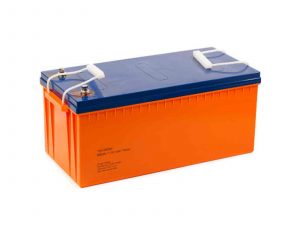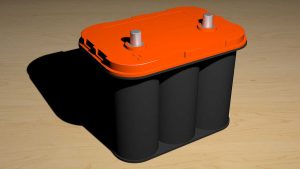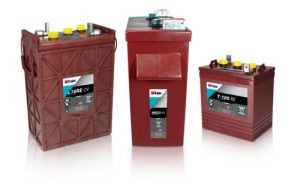Marine house batteries are used to power up equipment that requires a constant flow of energy. The one thing is that you can’t compromise when it comes to powering up your boat’s electrical system. There’s no substitute for a deep-cycle battery for powering the electrical system inside your boat.
The other factor is the battery chemistries of these batteries. There are two main types that you will come across i.e. Lead Acid AGM batteries and Lithium-ion or more specifically Lithium Iron Phosphate (LiFEPO4) batteries. We are comparing these two batteries.
Furthermore, marine batteries come with specific characteristics that make them different from standard car batteries or even deep-cycle batteries.
We look at the differences between AGM and Lithium Batteries and which one makes for a better choice for your battery bank.
Why use an AGM Battery on your Battery Bank
AGM deep cycle batteries are most often used in marine applications, RVs battery banks, rooftop solar systems, and other applications that require frequent charging or discharging of the battery without maintenance. because of their ability to withstand vibration and motion while being charged.

Spill-proof and Safe
An absorbed glass mat (AGM) battery uses a jelly-like electrolyte between its plates instead of liquid acid. It can also be called a “dry cell” because it doesn’t have any free liquid, which makes them spill-proof and safe to use in almost any position.
More Capacity
The electrolyte is composed of specially-coated micro-porous glass fibers that greatly increase surface area, which allows it to hold more acid than lead-acid batteries.
Portable
Because of using a glass mat instead of liquid it can be moved around more and can withstand shock and vibration.
Flexible Mounting
Again because of the glass mat plates the AGM battery can be mounted in any position but not upside down though.
Lower Internal Resistance
AGM batteries have a lower internal resistance compared to traditional lead-acid batteries. In the old types, resistance could be as high as 10-15% while in AGM it could be as low as 2% though this will increase as the batteries age.
Lower Internal resistance will mean a faster charging rate.
Do not require Ventilation
The electrolyte absorbs and releases oxygen during charging and discharging which recombines in a reaction called “the water cycle” to feed the chemical reaction. So it does not release harmful gases like the Wet Cell Lead Acid battery. You can therefore use this battery in an enclosed space.
Maintenance Free
As stated before these batteries do not require frequent filling with water. However, in some cases, excess gas may be produced such as when the battery is overcharged. It has a vent that releases the excess gas to maintain internal pressure.
Temperature Tolerance
AGM batteries generally perform better than most batteries including Lithium in all temperatures. This is especially in cold temperatures below freezing. The Glass mat doesn’t expand under freezing temperatures. This is also why AGM batteries have good Cold Cranking Amps (CCA) ratings making them the most used type of battery in Cars.
Depth of Discharge (DoD)
AGM batteries have an 80% depth of discharge which is better than flooded cell batteries at 50%. Depth of Discharge is how much of the battery’s capacity can be discharged without damaging it. However, it is not recommended to discharge an AGM battery below 50%.
At what voltage is an AGM Battery deeply discharged?
Why are Lithium-ion Batteries Better than AGM Batteries?
A Lithium-ion battery is a type of rechargeable battery, created by the lithium-ion movement of ions from the anode to the cathode for storage and directly back to the anode upon discharge. Improvements over lead-acid batteries include high capacity and energy density.
It’s also worth mentioning that Li-ion batteries exhibit very little memory effect, which means that the battery can be kept on the charger and it will not alter its charge/discharge cycles like some other types of batteries do (e.g., nickel-metal hydride) if they are regularly recharged before their power level indicator reaches zero – you can basically never run out unless your device was too low in power to turn on when plugged in!
The electrodes are composed of lithium, carbon, and a metal oxide mixture. The charged particles are ions that respond to an electric field in the material.
Lithium-ion batteries have many applications including in portable devices, Electric Vehicles, and Backup systems. However, they are different types of chemistries according to the type of Cathode and Anode Materials.
The most stable and safest type of Lithium-ion battery is the LiFePO4 (Lithium Iron Phosphate) which has become the most common replacement for Deep cycle Lead Acid batteries including the AGM battery.

A Lithium Iron Phosphate Battery is a type of lithium-ion battery that uses phosphate as an electrode material for its cathode, instead of the metallic lithium used in other Li-ion chemistries. Thus, it has a lower energy density than other Li-ion cells but this is compensated for by its long life cycle and stability. LiFePO4 batteries are less likely to catch fire when they are damaged or mistreated than other types of battery chemistries.
Lighter weight.
Lighter weight compared to lead-acid batteries which are twice the weight of LiFePO4. If you have 100 lbs of Lead-acid batteries, then you have 50 lbs with Lithium-ion batteries they equivalent runtime/capacity. This is why LiFePo4 batteries are used for portable applications.
High Discharge Rate
Li-Ion also has the capability to discharge at higher rates than other types of rechargeable batteries because it doesn’t generate heat while being discharged so it can still provide full power even at lower voltages.
Faster Recharge Rate
Expect to spend much less time recharging Lithium batteries than lead-acid batteries. This is because of the low internal resistance of the battery. While you can expect high charge efficiency of between 70% and 85% with AGM batteries.
Lithium batteries are typically 98% charge efficient. This means it takes most of the power that is put in the battery while recharging faster. This can be a time and resource saver, especially when using solar where you have limited time to get power from the sun.
Longer life
LiFePO4 battery cells also have a longer life cycle, up to 1000-2000 cycles while the lead-acid batteries are typically around 300–500 cycles. A LiFeP04 battery should last more than 3 times longer compared to other types of rechargeable batteries under normal use conditions.
Constant Voltage.
With Lithium-ion batteries, the voltage does not droop under a load and it maintains the same voltage until the battery is almost depleted. This means that your electrical appliances will run cooler and at full power with no drop-off in performance even when under heavy loads for longer periods of time.
In a lead-acid battery, the voltage will continue to drop over time as the internal circuit within the battery will self-discharge. This forces the connected electrical device to eventually shut down at its minimum operating voltage.
Eco-friendly.
Lithium batteries are the safest batteries for consumers and the environment. Internally, they do not contain corrosive sulfuric acid or any toxic heavy metals such as lead or cadmium which can be environmentally harmful if leaked.
A lithium iron phosphate cell is 3.2 V, nominally. This means that charging them above 3.6 V can cause gassing and damage to the cells.
If discharged too far, the protection circuit built into the cell will kick in and discharge itself down to 2V per cell. If this happens, it will be unable to recharge again without damaging the cells due to over-voltage protection since it is now fully charged, putting a constant load on the cells until they eventually pass away from old age (300–1000 cycles).
Can I Replace an AGM Battery with a Lithium-ion Battery?
Looking at the benefits of Lithium-ion batteries you will definitely look into replacing your AGM battery with a Lithium one. This is especially for your Marine house battery. Generally to get the same runtime as a Lead-Acid battery on a Lithium battery you just need 60% capacity of the Lead-Acid battery you are replacing.
However, for a dual-purpose or starter battery, you may need to stick to AGM batteries. This is because of the Cold-cranking amps (CCA). This is the number of amps that can be delivered at 0°F without the battery voltage dropping below 7.2 volts, also called “Low-Temperature Cranking Amps.”
A higher CCA value indicates that it may take longer to start your vehicle or boat in cold weather when its outside temperature drops below 32° F, but usually does not negatively affect driving in warmer temperatures.
One of the major reasons why you should not go for Lithium batteries is because they cannot be discharged below freezing or 24 degrees Fahrenheit. You will need to place the batteries in a warm enclosed area or cover them with blankets to use them in cold temperatures.
Secondly, Lithium-ion batteries are significantly more expensive than standard lead-acid models due to the underlying technology that goes into each one of them. You can expect to pay upwards of $0.50 per amp of current for lithium-ion vs about $0.20- $0.30 per amp for lead-acid batteries.
To help you find the perfect battery for your boat’s needs, let’s take a look at some of the most common types of marine batteries available.
Types of Marine Batteries
Every marine battery comes with a series of features that make it different depending on the type of use. A battery that is used for starting is different than the battery that powers your boat’s electrical system and there are also batteries that can be used for both.
Starting Marine Batteries
These come with high voltages (typically 12 volts) and can be used as an extremely powerful jump starter for vehicles. They’re designed to provide short bursts of energy for applications where you need a quick boost, such as cranking up the engine on your boat or vehicles that require large amounts of power during startup.

Starting marine batteries come in both flooded lead acid design and sealed lead-acid designs. We cover this later in the article.
Deep Cycle Marine Batteries
The main characteristic of deep cycle marine batteries is that they’re designed to discharge power over a long period of time. They tend to last longer than any other type of marine battery and are ideal for powering up trolling motors, GPS units, fish finders, and similar equipment found onboard boats.

These batteries also come in both flooded lead-acid and sealed AGM designs. Since they’re designed to discharge power slowly over an extended period of time, deep cycle batteries can be used as backups when your boat’s main engine is turned off.
For example, if you want to charge your devices or plug in a coffee maker or blender while cruising around the bay during the day, using a deep cycle battery would be wise since it can provide power for longer periods of time than starting batteries. A deep-cycle battery is the best for storage applications including solar and backup power.
Dual Purpose Marine Batteries
The Dual-purpose battery is made to do both functions of a starting and a deep cycle battery. They come in both flooded lead-acid and sealed AGM styles like starting batteries. They will also have a CCA rating just like a starting battery.
They can provide power for longer periods of time than the starting batteries. But not as well as deep-cycle batteries. They don’t do either function that well. Because they’re built to supply more power while draining less power from the alternator, dual-purpose batteries tend to last longer than conventional models.
How Lead Acid Batteries Work
Lead-acid batteries are some of the most common types of batteries on the market. They’re used as a powerful source of energy for everything from cars to solar energy grids and can be charged up by restoring the chemical lead sulfate back into its natural crystalline form.
There are three main types of lead-acid batteries: Flooded and Sealed Lead Acid batteries. SLA batteries are further divided into AGM and Gel.
Flooded Lead Acid Batteries – Flooded lead-acid batteries are the most common type of lead-acid battery. These types of batteries feature thick plates made up of active materials including lead oxide, which is an efficient conductor of electricity.
After discharging power, users can restore the chemical lead sulfate back to its natural crystalline form by recharging the battery. These batteries are high maintenance; require ventilation and are constantly filled with distilled water, are heavy, and not suitable for portable use. However, they are cheap and make for a great hobby for some.

Sealed Lead Acid Batteries (SLA)
Sealed Lead Acid Batteries or SLA are also referred to as ‘maintenance-free’ batteries because, unlike the Wet cell type these batteries have an electrolyte composed of either absorbed glass mat (AGM) or gel which both inhibit the loss of water and minimizes the emission of gas. This is why they are referred to as maintenance-free as you can use them.
Difference Between AGM and Gel Batteries
The ‘AGM’ part stands for Absorbed Glass Mat, which is a thin piece of fiberglass saturated with electrolytes that make up the battery plate. Since these plates don’t feature water or another form of liquid-holding solution, they can’t dissipate and lose power while sitting on the shelf.
However, the downside to this technology is reduced capacity and lifespan (how long it can hold a charge before needing to be recharged) compared to its flooded counterpart.
Gel cells feature plates made up of porous separators soaked in electrolytes, but they come with a thicker paste used as a temporary holding solution. The thicker paste reduces the amount of water evaporation that occurs over time, which prevents the battery from drying out. Gel batteries are highly sensitive to overcharging and don’t respond well to high energy demands.
Leave a Reply